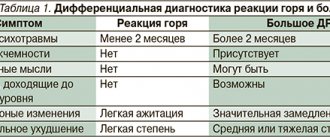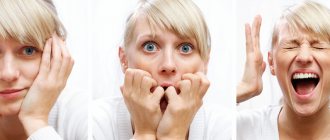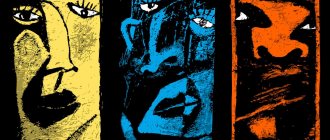- Affective respiratory syndrome
Mental disorders accompanied by a sharp change in a person’s emotional state are classified as affective disorders. They can be characterized by a sharp change in dynamics, disturbances in the manifestations of standard human emotions. Treatment of affective disorder in a specialized clinic in most situations can give a favorable prognosis for improving well-being and self-perception.
Affective disorder syndromes
Depending on the prevailing symptoms, various syndromes of affective disorders are distinguished:
- Depression associated with metabolic disorders of brain tissue. Manifestations of depression are associated with the patient experiencing a state of extreme despondency and hopelessness. This syndrome is characterized by suicidal thoughts, often leading to attempts to end one’s existence. Without the necessary therapy, the syndrome can last for a long period.
- Dysthymia differs from depression in its milder form. The patient becomes depressed during the day, anxiety increases, and mood worsens.
- In bipolar disorder, the patient experiences alternating phases of depressed mood and euphoria. Previously, this disease was called “manic-depressive psychosis.” In a depressed state, the patient's mood is depressed. Moving into the manic stage, the patient becomes cheerful, often excessively active, aggression, delusional ideas and irritability appear. In the case of the maximum stage of manifestation of changes in states, bipolar disorder is called cyclomia.
- In the case of depressive disorders, the patient suffers from increased anxiety, fear, and internal restlessness. The patient constantly expects the onset of tragedy, impending disaster. In severe cases, movement disorder and panic attacks are possible.
- Cotard's syndrome is accompanied by nihilistic-hypochondriacal delusions, accompanied by ideas of enormity. Occurs in involutional melancholia and recurrent depression.
- Manic syndrome (mania) is accompanied by a high level of joyful mood. The patient suffers from an increased desire for constant activity, there is an increased level of optimism, cheerfulness, and inadequate joy. Attention is distracted, superficiality of judgments is visible, verbosity, hypermnesia, thoughts are not completed, fatigue is absent, the attitude towards oneself is idealized. There is a mild manic state (hypomania).
Affective disorders require immediate consultation with a specialist. They often become the debut of various mental disorders. They are capable of persisting throughout the entire period of subsequent mental illness.
Anxiety disorder
With an anxiety disorder, the patient is dominated by tension, fear, and worry. He constantly expects a negative event (the presence of a dangerous illness in himself or a loved one, the death of a relative, etc.), the probability of which is low. All his thoughts and conversations are occupied by contrived “grief,” his appetite decreases, and insomnia begins.
In severe cases of anxiety, agitation may occur with constant pacing around the room and an inability to sit still. Panic attacks are simultaneously manifested by autonomic disorders - increased sweating, fluctuations in blood pressure, shortness of breath, nausea and dizziness.
Treatment of mood disorders
In medical practice, treatment for affective disorders is developed individually for each patient. It is necessary to take into account the present symptoms and the presence of additional diseases. When developing a program, procedures are carried out to:
- stop the active stage of the disease, if present;
- eliminate the cause of the pathology;
- carry out psychotherapeutic work;
- with the help of social work, increase adaptive abilities.
The composition of an integrated approach to the treatment of all types of syndromes includes:
- use of drug treatment;
- psychotherapy;
- social rehabilitation.
In case of acute exacerbation, suicidal thoughts, hospitalization is recommended. Each type of disease requires separate approaches when developing a course.
Affective mood disorder
Almost everyone has experienced mood swings, often without specific reasons. In some cases, such changes, caused by fatigue or based on pleasant occasions, cease to be only one of the manifestations of the norm. In this situation, they require diagnostics and development of a treatment program.
The cause may be genetic predisposition or external factors. For example, a strong shock caused by the death of a loved one. The reason is joy.
To correct the condition, a personal conversation between a specialist and a doctor is required to establish an accurate diagnosis. Elimination of provoking factors allows the state of affect to be relieved. Treatment uses sedatives and antidepressants.
Affective mental disorder
In such a situation, the patient’s condition becomes pathological and interferes with his normal life activities. Therapy is often lengthy. Requires the use of pharmacological drugs.
As in other situations with this disease, first of all the patient is removed from the acute attack stage. Identification of causes that can become a provoking factor is carried out in consultation with a psychologist. The pathology is characterized by alternating periods of exacerbations and remissions. Supervision by a specialist at any stage and attendance at preventive examinations are required.
Affective spectrum disorders
In most cases, doctors try to eliminate manifestations of affective spectrum disorders in restrictive conditions. Hospitalization is required for acute manifestations. At the initial stage of confronting the pathology, relief drugs are used with combinations of neuroleptics and antipsychotics. The use of anticonvulsants of the Valproate group may be required.
In the presence of psychosomatic symptoms, second-generation antipsychotics are used. Such as Serdolex, Clopixol Acufaz. The second generation of these drugs has fewer side effects. Drug resistance after 4 weeks of use becomes a recommendation for the use of anticonvulsants. Lithium salt is prescribed.
Depressive affective disorder
Directly translated in Latin, depression is called “dejection.” This condition cannot be completely cured today, but it can be corrected and stopped. Therapy helps improve the psychological and physiological state of the patient. Using a combination of psychological and biological treatment. In addition to medicinal drugs, folk recipes are distinguished by a high degree of effectiveness. First of all, herbal soothing teas, yoga. Patients are shown psychotraining courses and soothing baths. Following the rules of a healthy diet and avoiding alcohol plays a positive role.
Organic affective disorder
Antidepressants are used in treatment. They improve emotional well-being and reduce anxiety levels. It is necessary to remove the factors that provoked the condition.
An organic affective state is caused by physiological factors. Such as a long-term illness, withdrawal of certain medications, consequences of traumatic brain injury, postoperative condition.
The prescription of medications is carried out taking into account the medications that the patient is forced to take in accordance with the main diagnosis. In most situations, doctors prefer to focus on the use of psychotherapy, soothing infusions and teas, and physiotherapeutic procedures.
Manic affective disorder
The problem for conducting a successful course is often the patient's rejection of the diagnosis. A full examination is carried out to exclude concomitant dementia or schizophrenia. During therapy, sessions with a psychotherapist and prescription of medications are used. Anticonvulsant therapy is recommended.
In case of severe cases, compulsory hospitalization is required. In such a situation, doctors need the support of the patient's relatives.
Emotionally affective disorders
With such a lesion, a maximum change in the perception of the surrounding world occurs. The reaction to the provoking factor becomes excessive. There is a loss of understanding of the surrounding situation, and at the same time the understanding of a person’s actions in the current situation decreases.
The provocateur is prolonged exposure to traumatic events, leading to a pathological reaction of the brain. The patient loses control and does not adequately evaluate the actions taking place. Among the provocateurs are the death of a loved one, a sharp decline in social status and material level, and the occurrence of hormonal imbalance. The therapy uses tricyclic antidepressants, antipsychotics, mood stabilizers, tranquilizers, and mood stabilizers.
In the absence of positive dynamics, anticonvulsant therapy is prescribed. Psychotherapy sessions are conducted both with the patient himself and with his environment.
Bipolar disorder treatment
Courses of mood stabilizers are used for therapy. Such as Carbamazepine, lithium therapy, valproic acid. Treatment is divided into the stage of removing the patient from the acute stage and further preventive therapy, which can be carried out for life. At this stage, the use of a lithium solution is recommended. When you stop taking it, about half of patients relapse within a few weeks. Complete withdrawal within 5 years leads to relapse in 94% of patients.
This remedy shows a positive effect in 60% of patients with short cycles and up to 20% of patients with long cycles. Additional medications are prescribed. With the high potency of lithium, its positive effect occurs approximately 5 days after the start of treatment. During this period, other medications are used. Constant monitoring of the effect of the drug on the body is required. Treatment should be discontinued if dysarthria, widespread tremor and ataxia appear. Most often, negative symptoms are observed in the elderly and patients with poor health.
Causes
As already mentioned, the main “culprit” of organic mood disorder is a physiological factor. The most common reasons:
- Brain damage – tumor, traumatic brain injury affecting the frontal lobes.
- Diseases of the endocrine system - Itsenko-Cushing's disease, thyrotoxicosis, consequences of partial or complete removal of the thyroid gland, premenstrual and menopausal syndrome.
- Long-term use of hormonal drugs or their withdrawal. Those who suffer from autoimmune diseases and are forced to take glucocorticosteroids are especially at risk.
- Overdose of antihypertensive drugs, rarely - antibiotics, sedatives, antitumor drugs, narcotic analgesics.
The above-mentioned circumstances negatively affect the state of neurotransmitters responsible for transmitting impulses between nerve cells, and from them to the glands and muscle tissue. An imbalance of these biologically active substances disrupts this process, and the parts of the brain responsible for instinctive behavior, feelings and emotions end up working incorrectly.
Excess serotonin and norepinephrine speed up neurotransmission, making receptors more sensitive. This contributes to a manic state. A deficiency of these hormones provokes depression.
Bipolar affective disorder symptoms
This disease leads to a person’s complete loss of orientation in the world around him. Suicidal thoughts arise, careers end, and interpersonal relationships are destroyed. The disorder provokes life-threatening antisocial behavior.
The main symptom is a sudden change in mood. Depression gives way to euphoria. The change of cycles is chaotic. The duration of the phases cannot be determined. Sometimes the phases last for years. In the interval between attacks, there are no outward manifestations of the diagnosis and the patient feels completely healthy.
During depression, irritability, unmotivated anger, hopelessness and embarrassment are noted. In the euphoric stage, the patient may be prone to excessive spending or uncontrolled sexual relations.
The physiological state changes during different phases. During the manic stage, the patient feels a surge of strength, he is overly active, mobile, laughs often, speech becomes loud, and movements are impulsive.
The depressive stage is characterized by a sharp loss of strength. It becomes difficult for a person not only to move, but also to think. The duration of the depressive state is about two weeks. A repetition of the change of state occurs in most cases at least once every two years with the most ideal course of the disease.
The onset of the disease often occurs at the age of 20-30 years. Relatives may mistake the condition for a mental disorder. On average, the disease affects two out of a hundred people.
Treatment
- Antipsychotics (eg, lithium, some anticonvulsants) and second-generation antipsychotics, or a combination of both
- Supportive treatment and psychotherapy
Treatment for bipolar disorder consists of three stages:
- Impact Treatment: Stabilization and Symptom Control
- Ongoing treatment: Achieving complete remission
- Maintenance treatment or prevention: Maintaining remission
Although most patients with hypomania can be treated on an outpatient basis, severe mania, like depression, often requires hospitalization.
Drug therapy for bipolar disorder
Medicines to treat bipolar disorder include:
- Mood stabilizers: lithium and some anticonvulsants, in particular valproate, carbamazepine and lamotrigine
- 2nd generation antipsychotics: Aripiprazole, Lurasidone, Olanzapine, Quetiapine, Risperidone and Ziprasidone
These drugs are prescribed either individually or in combination at all stages of treatment, although in different dosages.
Choosing drug treatment for bipolar disorder can be difficult because all medications have significant side effects, frequent drug interactions, and no one drug is universally effective. The choice should be based on what has previously been effective and well tolerated in a given patient. If the patient has not previously been prescribed medications for bipolar disorder (or the drug history is unknown), the choice depends on the patient's medical history (depending on the adverse effects of the specific mood stabilizer) and the severity of symptoms.
Some specific antidepressants (eg, SSRIs) are also prescribed to treat severe forms of depression, but their effectiveness is controversial; they are not recommended as the sole treatment for depressive episodes.
Other Treatment Options
Phototherapy is useful for the treatment of seasonal bipolar disorders type I or II (autumn-winter depression and spring-summer hypomania). This method is especially effective as an adjuvant treatment.
Education and psychotherapy
By enlisting the support of loved ones, the doctor can prevent the development of major episodes of mood disorders.
Group therapy is often recommended for patients . In these classes, they will learn about bipolar disorder, its consequences, and the important role of mood stabilizers in the treatment of this disorder.
Individual psychotherapy can help patients cope with life's difficulties and embark on a new path of self-awareness.
Patients, especially those with bipolar II disorder, have poor adherence to the prescribed regimen because they believe that these drugs make them less alert and creative. The doctor can explain that a decrease in creative abilities is relatively rare, because mood stabilizers help achieve harmony in the interpersonal, scholastic, professional and creative aspects of life.
Patients should be warned to avoid stimulant medications and alcohol to minimize sleep disturbances and to identify early signs of relapse.
If the patient is prone to squandering, then control of the family budget should be transferred to family members. Patients with sexual hyperactivity should be told about the consequences of this behavior for the family (eg, divorce) and the risk of contracting infectious diseases such as AIDS.
Support groups (for example, the Depression and Bipolar Disorder Support Network) can help patients by providing an opportunity to share experiences and feelings with other patients.
Bipolar affective disorder diagnosis
The diagnosis is carried out by a psychiatrist or psychotherapist. When determining the diagnosis, the following is carried out:
- conversation with the patient and his environment;
- conducting a pathopsychological study by a clinical psychologist;
- laboratory tests are performed, including a blood test, neurotest, EEG, and a neurophysiological test system is prescribed;
- Consultations with a neurologist, cardiologist, and endocrinologist are necessary.
In difficult cases, it is recommended to undergo a medical commission that brings together several specialists. At the moment, signs of the disease cannot be detected using CT and MRI.
Symptoms of mood disorders
Accurate diagnosis of affective disorders is complicated by a wide range of causes that can provoke deterioration in health. The disease cannot be self-diagnosed. Only a psychiatrist or psychotherapist can give an accurate assessment. Specialists determine the exact diagnosis.
However, in medical practice there is a list of symptoms that suggest the presence of an affective disorder. Signs common to all types:
- mood changes occur with high frequency for a long period;
- the level of activity and mental pace decreases;
- a person’s perception of himself and situations changes dramatically;
- a noticeable decrease in the level of activity, depression, loss of interest in what is happening;
- appetite changes, usually decreases to complete starvation, but can also increase sharply;
- the patient is tormented by lack of sleep;
- moral suffering can lead to pain in any part of the body without any reason;
- sexual activity decreases, to complete asexuality.
Correct treatment can only be prescribed by a specialist after consultation.
Types of Mood Disorders
All types of affective disorders are described in the international classifier under the ICD 10 code, episodes F30-39. According to the classifier, types are defined as follows:
- F30 manic episode, diagnosed only in the case of a one-time manifestation of the disease; if repeated, doctors establish the fact of bipolar disorder;
- F31 bipolar mental disorder, characterized by recurrent occurrences;
- F32 depressive episode, accompanied by a decrease in activity, the presence of a depressed mood, increased fatigue, decreased appetite, insomnia, decreased self-confidence and self-esteem. It can be mild, pronounced and severe.
- F33 recurrent depressive disorder is defined by the presence of recurrent episodes of depression. There are no mood swings, with the change from mania to euphoria. The onset of the disease is possible at any age. Including in childhood. With a manic episode, especially if it recurs, it is classified as bipolar disorder.
- F34 persistent mood disorders that last for years, often throughout life, but are not severe enough to be classified as a mild depressive episode or a hippomanic episode.
- F38 Other mood disorders that do not fall into the types listed.
- F39 NOS (affective psychosis).
The diagnosis is made in a clinical setting. Accurate diagnosis is carried out only by a qualified psychotherapist or psychologist.
Classification of organic mood disorder and symptoms
There are two degrees of severity of this pathology:
- psychotic – characterized by inappropriate reactions, lack of control of behavior, and uncriticality of the patient’s own condition;
- non-psychotic - although emotions are at their peak, the patient, understanding what is happening to him, can partially regulate behavior and comply with accepted norms in society.
As for the manifestations, they are as follows:
- manic - accompanied by a feeling of immense happiness, universal joy. The patient is hyperactive, fussy, in high spirits, behaves very relaxed, can literally move mountains;
- depressive - the individual is overcome with melancholy, he cannot do anything, he is depressed, sad, the mental sphere is depressed;
- bipolar - mania and depression cyclically replace one another;
- mixed or combined - the above states alternate chaotically.
The clinical picture of organic affective disorder depends on its form.
Depressed patients have a low mood, are apathetic, passive, sad, and show no interest in anything. It is difficult for him to perform physical and mental work; his head, as they say, does not cook, he is even dizzy. The muscles are sluggish and fatigue sets in quickly. The patient cannot concentrate and collect thoughts “in a heap”, thinks about the uselessness of his existence, is disappointed in life, blames himself for something. No appetite, can't sleep.
Manic disorder , on the contrary, is characterized by high mood, activity of thought and movement. The individual acts chaotically, quickly, but aimlessly. He thinks quickly, the process of cognition is accelerated, but shallow, since he cannot fully analyze anything. The behavior is impulsive, difficulties that arise encourage aggression. With the psychotic severity of the disorder, delusional states may occur.
If measures are not taken in time, then organic affective mood disorder is fraught with big problems. Depressed patients withdraw into themselves, do not want to contact anyone, and lie in bed all day long. Their condition may deteriorate so much that it may end in suicide. In manic patients, an outburst of aggression can lead to an antisocial act or crime. Unable to resist the excitement, they start fights, damage other people's property, etc.
Diagnosis of affective disorders
In the case of sudden mood swings, the presence of affective disorders can be assumed. Common to all types of these diagnoses is a possible connection with seasonality. Exacerbations are often associated with climatic changes in natural conditions. Activation of the diagnosis is directly related to stressful situations in most patients.
The patient or his relatives can only assume the possible presence of such a diagnosis. For an accurate determination, a visit to the doctor is required. Installation is carried out after a personal consultation with a psychologist or psychotherapist. Mood disorders cannot be completely cured. In order to exclude relapses, observation by a doctor will be lifelong.
To establish a diagnosis, laboratory tests are performed: EEG, blood test. First of all, they are designed to exclude the presence of additional diagnoses. MRI or CT scans are not used for research.
Diagnostics
- Clinical criteria (Diagnostic and Statistical Manual of Mental Disorders, 5th edition)
- Thyroxine (T4) and TSH levels to rule out hyperthyroidism
- Exclusion of the fact of use of psychostimulants - clinically or by blood or urine analysis
Diagnosis of bipolar disorder is based on identification of the symptoms of mania or hypomania described above and a history of the disease. Symptoms must be severe enough to significantly impair social or occupational activities or require hospitalization to prevent harm to self or others.
Some patients with depressive symptoms may have previously experienced episodes of hypomania or mania, but they will not disclose this unless specifically asked. Skillful interviewing may reveal distressing signs (eg, excessive spending, impulsive sexual escapades, drug abuse), although such information is likely to be provided by relatives. A structured inventory such as the Mood Disorder Questionnaire may be helpful. All patients should be asked in a gentle but frank manner about suicidal tendencies, plans, or attempts.
Similar acute manic or hypomanic symptoms may occur as a result of stimulant abuse or medical disorders such as hyperthyroidism or pheochromocytoma. Patients with hyperthyroidism typically have other physical symptoms and signs, but thyroid hormone testing (T4 and TSH) is recommended as part of the initial diagnosis. Patients with pheochromocytoma suffer from severe hypertension; if not, then testing is not indicated. Other disorders are less likely to cause symptoms of mania, but depressive symptoms can occur in a number of disorders.
Taking a history of substance use (especially amphetamines and cocaine) and screening blood or urine for the presence of drugs can help determine a drug cause of the condition. However, because the episode could be caused by drug use in a patient with bipolar disorder, looking for the presence of symptoms (manic or depressive) not related to drug use is important.
Some patients suffering from schizoaffective disorder exhibit manic symptoms, but such patients may not return to normal between episodes.
People with bipolar disorder may also develop anxiety disorders (eg, social phobia, panic attacks, obsessive-compulsive disorder), which can make diagnosis difficult.
Affective personality disorder
Mood dysregulation affects many people throughout their lives. Impressionable citizens who are prone to heightened perception of what is happening suffer from such changes or are simply different. But not all cases of dysregulation are clinical.
The pathology is characterized by a noticeable and cyclical change of depression and euphoria. In the absence of treatment, such changes can occur even without additional provoking factors.
Patients suffering from affective personality disorder of any type are rarely able to control the change in their condition. To monitor the condition, observation by a specialist is required in order to promptly initiate drug treatment. Affective personality disorder without treatment leads to the destruction of the patient’s personality. It reduces the quality of life and destroys personal and social life. Periods of low and high energy destroy the body, often leading to suicidal tendencies.
Causes of affect
Among the causes of affect are:
- The emergence of circumstances that threaten a person’s physical existence, related to his biological instincts and needs.
- Conflict, contradiction between a person’s strong attraction, desire, desire for something and the objective impossibility of satisfying the urge that has arisen.
- Actions of others that affect a person’s self-esteem and traumatize his personality.
Affect arises in an already existing specific situation and serves for the subject as a unique form of exit from it, a release. In an affectogenic situation, a person must act and feels an irresistible need to do so, but does not find suitable methods of action. This contradiction is what causes the affect. If a person clearly sees the possibilities of adequate behavior, affect does not occur.
Individual psychological characteristics predisposing to the development of affective states are:
- A complex of innate properties of the nervous system (in people with a weak type of nervous system, which is characterized by mild excitability, increased sensitivity to stimuli, low resistance to strong stimuli).
- The specific structure of personality, in particular, the features of its self-esteem.
- Age characteristics of the subject.
- Temporary functional psychophysiological states that disrupt a person’s resistance to an affectogenic situation (fatigue, insomnia, menstrual periods in women, etc.).
Seasonal affective disorder
It is observed in people prone to seasonal depression. The periods occur at approximately the same time of year. Within the general disorder it is classified as F32.1.
There are two types. The most common is winter, starting in the autumn months. Typically in September and October. The active period lasts until early spring. Much less common is the summer type, which lasts from early spring to late autumn.
The first attack in most cases occurs between 15 and 55 years. The average age of patients first presenting with seasonal affective disorder is 23 years. The risk of developing the disease decreases with age. Depending on the season, women suffer from depression more often than men.
About a third of patients tolerate seasonal depression quite easily. The disease manifests itself in the form of some loss of strength and deterioration in mood. Most patients experience seasonal depression with difficulty. They worsen the quality of life, destroy personal relationships, and ruin careers.
At risk are:
- people with a family history of mood disorders and GAP;
- residents of northern latitudes, where daylight hours are very short most of the day.
Patients suffer from decreased libido, increased drowsiness, hypochondria, and continued fatigue despite long periods of rest. Autonomic disorders are observed.
This type of affective disorder in most situations goes away completely on its own after the season ends.
As a result, it is worth noting that with proper treatment, affective disorders are successfully corrected, moving into a state of stable remission. To avoid relapses, patients require constant medical supervision, compliance with recommendations and, if necessary, taking medications.
Affective syndrome is a fairly common cause of disruption of the human body. It is characterized by the onset of changes in the functioning of the brain at the dienfective level. Due to this, the regulation of the biotones of the body is disrupted; due to a decrease in their regulation, mood and the pace of mental processes occur. Treatment of affective syndrome is carried out under the supervision of specialists.
Questions and answers
How long should depression be treated?
It all depends on the type and severity of the depressive state; in each specific case, the duration of medication and rehabilitation therapy may vary. The first effect after starting treatment becomes noticeable in about 1-2 weeks. For more detailed information, it is best to consult your doctor.
Do people with bipolar disorder need to be hospitalized?
In mild cases of the disease, a person’s condition can be improved on an outpatient basis. But severe mania or severe depression requires adjustment of medications taken and round-the-clock monitoring, and this is only possible during the patient’s hospital stay.
Manifestation of affective syndrome
Pathology manifests itself in the form of negative emotional disorders, depressive states and mania. In some cases, accompanied by physiological disorders:
- difficulty breathing with a feeling of incomplete inspiration;
- heaviness in the chest;
- inhibition of movements and reactions;
- slowing down thought processes;
- loss of interest in things that were previously important to the patient.
Various types of depressive states manifested in pathology:
- manic-depressive psychoses;
- psychogenic depression;
- endogenous depressive states;
- depression of a somatic nature.
It is characterized by a sharp change, often occurring within one day. The period of attacks can last for several months and even years. Sleep disturbances are observed, appetite changes, and weight loss may occur.
Treatment of affective syndrome
When eliminating pathology, complex therapy is used with the use of medications and psychological training. Patients with mental disorders manifested in panic attacks are prescribed classes to master self-regulation techniques. Work is being done to improve self-esteem.
Social adaptation is used for successful therapy. In such a situation, the participation of family members and the patient’s immediate environment is recommended in group psychological trainings.
Affective syndrome in children
Affective disorders of depressive and manic types occur not only in adult patients, but also in children. Medicine is not able to accurately determine the cause of these disorders in minors. Provoking factors include genetic predisposition and constant traumatic situations. Manifestations are observed at the earliest stages of child development. The period from 12 to 20 months is especially dangerous for the start of the diagnosis.
The unstable psycho-emotional state of the baby with frequent mood swings allows one to suspect the presence of a diagnosis. Children suffer from hallucinations. Attacks may occur over significant time intervals. Immediate medical attention is required:
- in case of threats to commit suicide;
- attempts to cause physical harm to oneself;
- identifying cases of hallucinations.
Treatment is carried out jointly by a child psychologist, a psychiatrist, and a pediatrician. Due to the lack of a clear understanding of the causes of the onset of the disease, there are no preventive measures. If the disease is detected early, the prognosis is favorable. The combination of drug therapy and psychological practices makes it possible to reverse the development of pathology in a child.
A type of affective syndrome
Diagnosis and successful initiation of treatment for affective syndrome is associated with a clear definition of the type of pathology.
Affective respiratory syndrome
The cause of the onset of pathology is a serious psycho-emotional stimulus. Accompanied by attacks of suffocation, panic attacks caused by the inability to continue normal breathing. It occurs quite rarely in adult patients, due to the acquisition of the skill to control one’s emotional state in the event of sudden moral and physical shocks.
Affectively delusional syndrome
A polymorphic psychotic disorder, often caused by schizophrenia. Manifestations in situations of diagnosing delirium and depression in patients suffering from various mental illnesses.
Affectively paranoid syndrome
Refers to exacerbations in recurrent and schizophrenia, acute paraphrenia and other psychiatric diagnoses. It manifests itself as symptoms of switching off consciousness in the form of coma, a state of stupor, hypochondria, and a constant feeling of guilt. Accompanied by movement disorders. Such as agitation, the speed of associations changes from complete slowdown to acceleration at the level of a “whirlwind of ideas.”
Affectively endogenous syndrome
Occurs with endogenous diagnoses, somatogenic mental pathologies. Accompanied by frequent changes in mood phases. The maximum duration of depressive periods lasts up to 6 months. During the period of remission, the pathology may be virtually invisible.
Affective respiratory syndrome in children
It is a frequent response of the body to sudden provoking situations in the form of holding or even stopping breathing. This manifestation also occurs in a situation of prolonged prolonged crying. May be accompanied by convulsions and loss of consciousness. In rare situations, it turns into epilepsy.
Affective instability syndrome
A state of emotional instability that is on the verge of normal. It is recommended to contact a specialist:
- in case of frequent breakdowns, the so-called “crazy”;
- affective outbursts;
- mood swings, often occurring at an unconscious level;
- low level behavior control.
Manifestations in most situations are associated with stressful conditions and weather changes. Unstable psychopathy borders on schizophrenia.
Affective depressive syndrome
Constantly depressed mood, energy and performance decrease, often patients are characterized by a refusal to control their appearance. Ungrooming appears. The mood does not improve in pleasant company. Thoughts about suicide often appear.
Affective pathology syndromes
Extremely diverse. A common symptom is a disturbance in the emotional state from a state of excessive joy to deep depression. If frequent mood swings are detected, it is recommended to consult a specialist for an accurate diagnosis.
Affectively hallucinatory syndrome
It is characterized by a combination of delusional and hallucinogenic disorders. Patients may experience visual and auditory hallucinations, decreased emotional status, or, conversely, increased agitation.
What it is?
An affective outburst is a discharge of stagnant affect. It is characterized by a short-term emotional outburst with violent motor activity and disturbances in the functioning of internal organs.
Affects are not categorized as feelings, emotions and moods. Affects reflect the subjective perception of the situation, accompanied by pronounced changes in behavior and functioning of the central nervous system. That is, an affective outburst always (!) occurs as a reaction to some situation that causes an intense response from the nervous system.
They are:
- Physiological nature;
- Pathological in nature.
Affective outbursts of a physiological nature do not entail a loss of self-control, but refer to the normal expression of emotions, which is not painful. Pathological outbreaks are characterized by complete or partial loss of consciousness, followed by amnesia.









